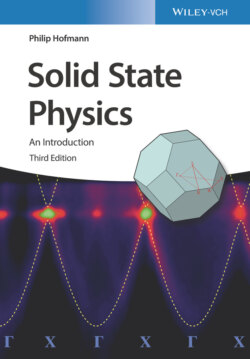Solid State Physics

Реклама. ООО «ЛитРес», ИНН: 7719571260.
Оглавление
Philip Hofmann. Solid State Physics
Table of Contents
List of Tables
List of Illustrations
Guide
Pages
Solid State Physics. An Introduction
Preface to the First Edition
Preface to the Second Edition
Preface to the Third Edition
Physical Constants and Energy Equivalents
1 Crystal Structures
1.1 General Description of Crystal Structures
1.2 Some Important Crystal Structures
1.2.1 Cubic Structures
1.2.2 Close‐Packed Structures
1.2.3 Structures of Covalently Bonded Solids
1.3 Crystal Structure Determination
1.3.1 X‐Ray Diffraction
1.3.1.1 Bragg Theory
1.3.1.2 Lattice Planes and Miller Indices
1.3.1.3 General Diffraction Theory
1.3.1.4 The Reciprocal Lattice
1.3.1.5 The Meaning of the Reciprocal Lattice
1.3.1.6 X‐Ray Diffraction from Periodic Structures
1.3.1.7 The Ewald Construction
1.3.1.8 Relation Between Bragg and Laue Theory
1.3.2 Other Methods for Structure Determination
1.3.3 Inelastic Scattering
1.4 Further Reading
1.5 Discussion and Problems. Discussion
Basic Concepts
Problems
Notes
2 Bonding in Solids
2.1 Attractive and Repulsive Forces
2.2 Ionic Bonding
2.3 Covalent Bonding
2.4 Metallic Bonding
2.5 Hydrogen Bonding
2.6 Van der Waals Bonding
2.7 Further Reading
2.8 Discussion and Problems. Discussion
Basic Concepts
Problems
Note
3 Mechanical Properties
3.1 Elastic Deformation
3.1.1 Macroscopic Picture. 3.1.1.1 Elastic Constants
3.1.1.2 Poisson's Ratio
3.1.1.3 Relation Between Elastic Constants
3.1.2 Microscopic Picture
3.2 Plastic Deformation
3.2.1 Estimate of the Yield Stress
3.2.2 Point Defects and Dislocations
3.2.3 The Role of Defects in Plastic Deformation
3.3 Fracture
3.4 Further Reading
3.5 Discussion and Problems. Discussion
Basic Concepts
Problems
Note
4 Thermal Properties of the Lattice
4.1 Lattice Vibrations
4.1.1 A Simple Harmonic Oscillator
4.1.2 An Infinite Chain of Atoms
4.1.2.1 One Atom Per Unit Cell
4.1.2.2 The First Brillouin Zone
4.1.2.3 Two Atoms per Unit Cell
4.1.3 A Finite Chain of Atoms
4.1.4 Quantized Vibrations, Phonons
4.1.5 Three‐Dimensional Solids
4.1.5.1 Generalization to Three Dimensions
4.1.5.2 Estimate of the Vibrational Frequencies from the Elastic Constants
4.2 Heat Capacity of the Lattice
4.2.1 Classical Theory and Experimental Results
4.2.2 Einstein Model
4.2.3 Debye Model
4.3 Thermal Conductivity
4.4 Thermal Expansion
4.5 Allotropic Phase Transitions and Melting
References
4.6 Further Reading
4.7 Discussion and Problems. Discussion
Basic Concepts
Problems
Notes
5 Electronic Properties of Metals: Classical Approach
5.1 Basic Assumptions of the Drude Model
5.2 Results from the Drude Model
5.2.1 DC Electrical Conductivity
5.2.2 Hall Effect
5.2.3 Optical Reflectivity of Metals
5.2.4 The Wiedemann–Franz Law
5.3 Shortcomings of the Drude Model
5.4 Further Reading
5.5 Discussion and Problems. Discussion
Basic Concepts
Problems
Notes
6 Electronic Properties of Solids: Quantum Mechanical Approach
6.1 The Idea of Energy Bands
6.2 The Free Electron Model. 6.2.1 The Quantum‐Mechanical Eigenstates
6.2.2 Electronic Heat Capacity
6.2.3 The Wiedemann–Franz Law
6.2.4 Screening
6.3 The General Form of the Electronic States
6.4 Nearly‐Free Electron Model: Band Formation
6.5 Tight‐binding Model
6.6 Energy Bands in Real Solids
6.7 Transport Properties
6.8 Brief Review of Some Key Ideas
References
6.9 Further Reading
6.10 Discussion and Problems. Discussion
Basic Concepts
Problems
Notes
7 Semiconductors
7.1 Intrinsic Semiconductors
7.1.1 Temperature Dependence of the Carrier Density
7.2 Doped Semiconductors
7.2.1 n and p Doping
7.2.2 Carrier Density
7.3 Conductivity of Semiconductors
7.4 Semiconductor Devices
7.4.1 The pn Junction
7.4.2 Transistors
7.4.3 Optoelectronic Devices
7.5 Further Reading
7.6 Discussion and Problems. Discussion
Basic Concepts
Problems
Note
8 Magnetism
8.1 Macroscopic Description
8.2 Quantum‐Mechanical Description of Magnetism
8.3 Paramagnetism and Diamagnetism in Atoms
8.4 Weak Magnetism in Solids
8.4.1 Diamagnetic Contributions. 8.4.1.1 Contribution from the Atoms
8.4.1.2 Contribution from the Free Electrons
8.4.2 Paramagnetic Contributions
8.4.2.1 Curie Paramagnetism
8.4.2.2 Pauli Paramagnetism
8.5 Magnetic Ordering
8.5.1 Magnetic Ordering and the Exchange Interaction
8.5.2 Magnetic Ordering for Localized Spins
8.5.3 Magnetic Ordering in a Band Picture
8.5.4 Ferromagnetic Domains
8.5.5 Hysteresis
Reference
8.6 Further Reading
8.7 Discussion and Problems. Discussion
Basic Concepts
Problems
Notes
9 Dielectrics
9.1 Macroscopic Description
9.2 Microscopic Polarization
9.3 The Local Field
9.4 Frequency Dependence of the Dielectric Constant. 9.4.1 Excitation of Lattice Vibrations
9.4.2 Electronic Transitions
9.5 Other Effects. 9.5.1 Impurities in Dielectrics
9.5.2 Ferroelectricity
9.5.3 Piezoelectricity
9.5.4 Dielectric Breakdown
9.6 Further Reading
9.7 Discussion and Problems. Discussion
Basic Concepts
Problems
Notes
10 Superconductivity
10.1 Basic Experimental Facts. 10.1.1 Zero Resistivity
10.1.2 The Meissner Effect
10.1.3 The Isotope Effect
10.2 Some Theoretical Aspects. 10.2.1 Phenomenological Theory
10.2.2 Microscopic BCS Theory
10.3 Experimental Detection of the Gap
10.4 Coherence of the Superconducting State
10.5 Type‐I and Type‐II Superconductors
10.6 High‐Temperature Superconductivity
10.7 Concluding Remarks
References
10.8 Further Reading
10.9 Discussion and Problems. Discussion
Basic Concepts
Problems
Notes
11 Finite Solids and Nanostructures
11.1 Quantum Confinement
11.2 Surfaces and Interfaces
11.3 Magnetism on the Nanoscale
11.4 Further Reading
11.5 Discussion and Problems. Discussion
Basic Concepts
Problems
Appendix A
A.1 Explicit Forms of Vector Operations
A.2 Differential Form of the Maxwell Equations
A.3 Maxwell Equations in Matter
Note
Appendix B. B.1 Solutions to Basic Concepts Questions
Index
WILEY END USER LICENSE AGREEMENT
Отрывок из книги
Third Edition
Philip Hofmann
.....
Equation 1.11 is our final result. It relates the measured intensity to the electron concentration in the sample. Except for very light elements, most of the electrons are located close to the ion cores and the electron concentration that scatters the X‐rays is essentially identical to the geometrical arrangement of the atomic cores. Hence, Eq. (1.11) can be used for the desired structure determination. To this end, one could try to measure the intensity as a function of scattering vector and to infer the structure from the result. This is a formidable task, however. It is greatly simplified by the fact that the specimen under investigation is a crystal with a periodic lattice. In the following, we introduce the mathematical tools and concepts that are needed to exploit the crystalline structure in the analysis. The most important of these is the so‐called reciprocal lattice.
.....